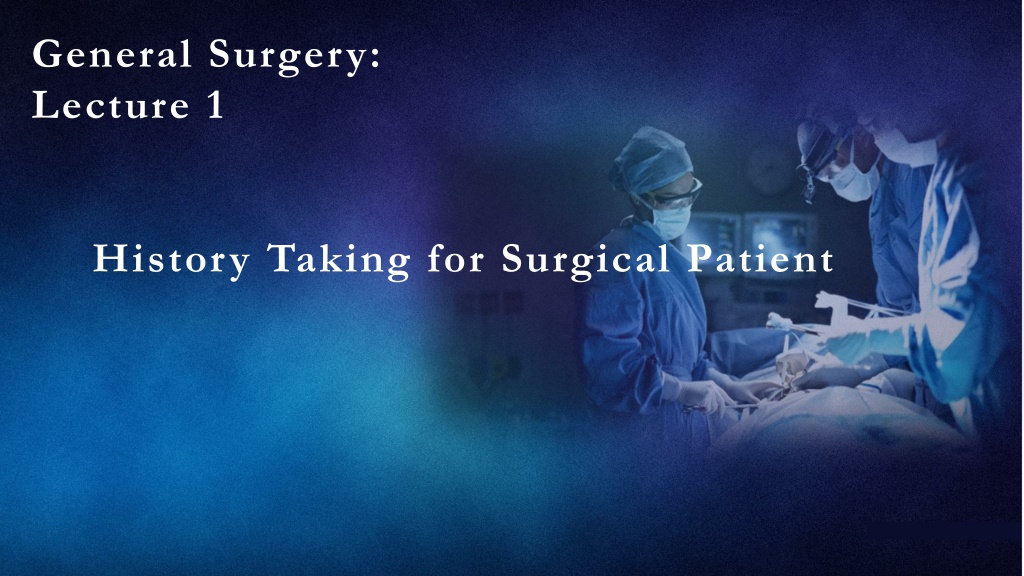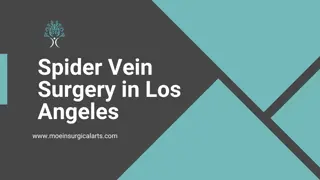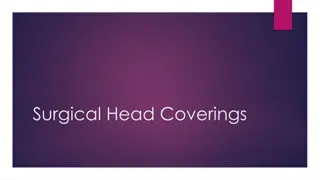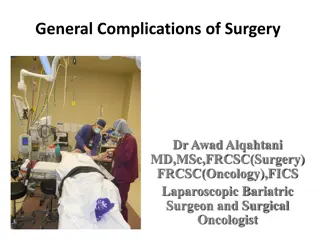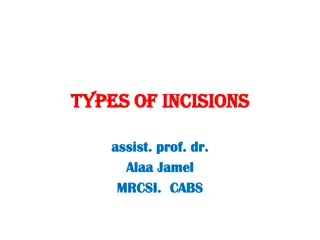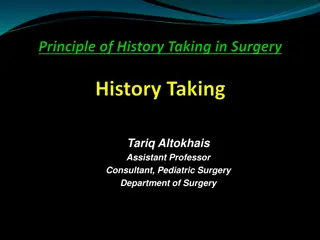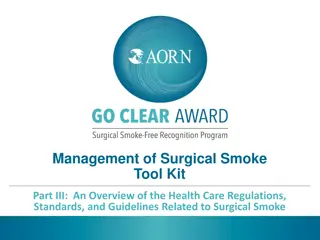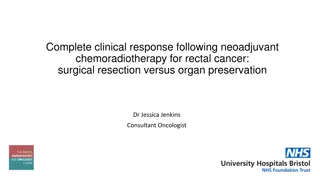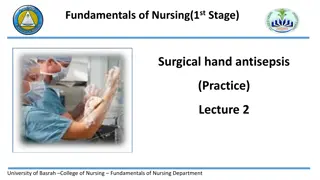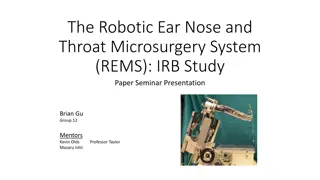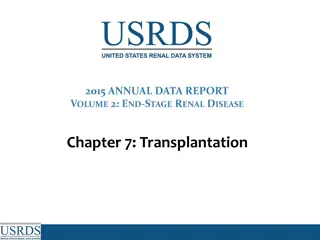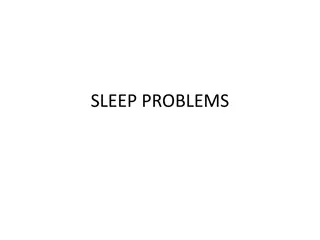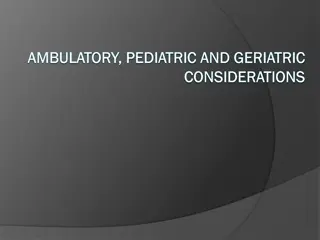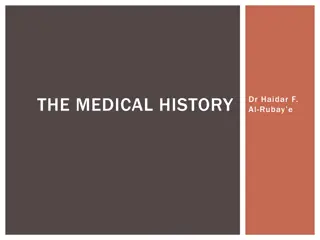Effective History Taking for Surgical Patients
Establishing clear goals, effective communication, and proper patient engagement are crucial in history taking for surgical patients. This process involves identifying symptoms, making diagnoses, understanding overall health status, and addressing patient concerns. It is essential to ask relevant questions, avoid leading questions, and maintain patient-focused conversations. Additionally, respecting patient privacy, avoiding interruptions, and obtaining accurate personal information contribute to a successful history-taking process in surgical care.
Download Presentation

Please find below an Image/Link to download the presentation.
The content on the website is provided AS IS for your information and personal use only. It may not be sold, licensed, or shared on other websites without obtaining consent from the author. Download presentation by click this link. If you encounter any issues during the download, it is possible that the publisher has removed the file from their server.
E N D
Presentation Transcript
General Surgery: Lecture 1 History Taking for Surgical Patient
The Goals behind history taking establish the system(s) responsible for the symptom(s) make a diagnosis identify a differential diagnosis gather information about the patient s overall health status clarify the nature of the disease process establish fitness for surgery/anaesthetic understand the patient s individual circumstances, and their concerns, ideas, expectations and beliefs.
Always introduce yourself to the patient and any accompanying person, and explain, if it is not immediately obvious, what your role is in helping them. Remember that patients are (usually) neither medically nor dentally trained, so use plain speech without speaking down to them. Questions are a key part of history-taking and the manner in which they are asked can lead to a quick diagnosis and a trusting patient
Leading questions should, by be avoided problem when the question suggests the answer, e.g. is the pain worse when you drink hot drinks? An important point is how to keep the patient conversation within the issue he/she is complaining about rather than talking about distracting subjects.
The Donts of History Don t interrupt the patient while he/she is telling you about the story of illness. Listen well but never allow the patient to guide you away in irrelevant stories. Specific complaint is pinpointed ? diagnosis Don t be abrupt (sudden, or very brief) Don t use medical terms while talking with your patient
Patients Personal Information NAME AGE Gender. MARIETAL STATE
1- The Name Identification. Registration. To elicit doctor patient familiarity (patient usually likes to be called by name) To avoid fatal mistakes. 2- AGE Certain diseases are common in certain age groups (e.g. congenital) Certain drugs may be hazardous in certain age groups (e.g. Quinolones, Tetracycline, NSAIDs )
Neonatal period = up to 1 month old Infancy = 1 month 2 years old Childhood = 2 12 years old Adolescence = 12 20 years old Adulthood = 20 40 years old Middle age = 40 60 years old Elderly = over 60 years old
Example for Age Relation Cleft lip .since birth Cystic hygroma ..infancy Thyroglossal cyst childhood Appendicitis adolescents & adults Trauma .adolescents & adults Cancer ..middle & old age
Cancer of childhood Ewing s tumor Neuroblastoma Acute Leukemia Wilm s Tumor (It is the most common type of kidney cancer in children).
3- The Gender Gender related diseases Hemophilia Buerger's disease thyroid diseases
Tips for effective conversations Speak clearly and audibly Ask open questions to start with Don t interrupt your patient Try and appear unhurried Use silence to encourage explanations Do not use jargon or emotive words Find out about your patient as a person Clarify and summaries what you understand you may need to do this more than once Make sure the story makes sense to you keep seeking facts until it does Acknowledge emotions Seek ideas, concerns and expectations Negotiate mutual goals
The Standards of History taking The seven Components of History Standardization of clinical records. Patient s story for the clinician evaluation. Going through the seven steps not always necessary, unless there is no starting point.
1. Presenting Complaint 2. History of presenting complaint (HPC) 3. Past medical history (PMH) 4. Drug history (DH) 5. Family history (FH) 6. Social history (SH) 7. Systems enquiry (review)
The 1st step, to recognize why the patient is seeking medical help. The Patient s own words, most important. This is the time to create relation with the patient. Listen to your patient Some patients come with the diagnosis, don t underestimate that point.
History of presenting complaint (HPC) explore in detail the history of the presenting complaint. When exactly did the problem start? Two weeks ago? Yesterday? If the patient struggles to clarify this, go right back and ask, for example: When did you last feel well? Then what happened? What next? Then what? Anything else?
The PQRST model. Originally developed for pain assessment, however, it been suggested to be used in assessment of different features. Pain usually the main reason that makes the patient seek treatment.
IN THE PATIENTS OWNWORDS (never use medical terms e.g. dysphagia = difficult swallowing. jaundice = yellowish discoloration of the eyes palpitation = rapid sensible heart beats. axilla = armpit inguinal region = groin ulcer = sore
Past medical history (PMH) Do you currently have any medical conditions? and Can you tell me about any medical conditions or operations that you have had in the past?
Patients may not disclose past medical history voluntarily, even when directly asked about specific areas. Sensitive areas (such as sexual/reproductive health, psychiatric history, alcohol/drug abuse) may require you to give an initial explanation of your reasons for asking You should also express understanding and acknowledgement of the sensitivity of the subject for the patient.
Drug history (DH) This is predominantly about current medications and drug allergies. 1. Do you take any regular prescribed medicines? 2. Are you allergic to any medicines or substances? 3. Do you take any medicines not prescribed, for example from the pharmacy? Have you tried any over-the-counter medicines from the pharmacy for the problem?
Question 1 answers will usually provide you with a list of oral medication but not necessary topical therapies, creams/patches/suppositories/inhalers, so you may need to ask about these as well. Question 2 answers may elicit information about several allergies but these will need to be clarified, as patients often mistake medication side effects for allergies question 3 you may need to give some examples of specific over-the-counter medicines. For instance, in the case study involving abdominal pain it would be important to enquire about the use of laxatives, antacids, analgesics, non-steroidal drugs and aspirin.
Family history (FH) Are there any relatives with a similar illness to this? Are there any illnesses that run in your family? (Highlight as appropriate some key illnesses that can run in families such as heart disease, hypertension, diabetes, cancer, stroke, epilepsy, asthma, eczema, arthritis, thyroid and sickle cell disease.) Are your parents/siblings alive? If not what were their causes of death?
Social history (SH) Exercise Lifestyle Diet occupation Travel history residence habits of importance You can mention residence & occupation in Arabic if you don t know in English.
occupational diseases: porters (carrier) HERNIAS Farmers Bilharzias = SPLENOMEGALLY typists, pianists, drill workers ..RAYNAUD S PHENOMENON teachers, surgeons, nurses .VARICOSE VEINS intellectual HTN, Peptic Ulcer exposure to carcinogens
Travel History List the countries visited and the dates they were there. Enquire about the type of accommodation used and the activities undertaken
Standard of living (social class): diseases of high social class: Duodenal ulcer Irritable Bowel Syndrome. diseases of low social class: TB Parasitic infestations
HABITS OF SURGICAL IMPORTANCE Smoking Tea & Coffee abuse Alcohol intake I.V. drug addiction Auto-medications Diet habits
Smoking Type of Smoke Duration Many systems affected
Alcohol intake type of drink duration of drinking & if stopped amount of intake per day
delirium. myopathy. gastritis. hyperlipidemia. addiction. tremors. cardiomyopathy. alcoholic cirrhosis.
How to count alcohol units. You have to know the quantity and type of alcohol or drink Hazardous drinking is the regular consumption of more than: 24 g of pure ethanol (3 units) per day for men 14 g of pure ethanol (2 units) per day for women.
Tea & Coffee abuse INSOMNIA HYPERACIDITY DIURESIS CONSTIPATION
DRUG ADDICTION type of drug duration of addiction & if stopped amount of intake hazards of I.V. drug addiction: AIDS INFECTIVE HEPATITIS INFECTIVE ENDOCARDITIS MALARIA
DIET HABITS excessive fat in diet obesity, fatty, liver, atherosclerosis, cholecystitis excessive spices in diet gastritis, PU, hemorrhoids
